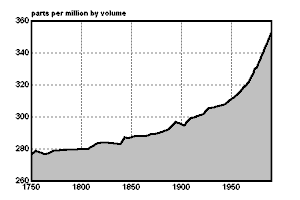 Introduction
Introduction Introduction
IntroductionThe greenhouse effect itself is a well-established physical process. Concern about global warming is based on the scientific evidence that the greenhouse effect is being strengthened as a result of human activity.
The composition of the atmosphere has already undergone a radical change as a result of industrialization.

Atmospheric carbon dioxide concentrations, derived from direct observations
and ice core measurements.
The amount of carbon dioxide in the atmosphere has risen by a quarter since the late 18th century, to a 1991 concentration of 355ppmv (parts per million by volume). The rate of change is accelerating and around half the increase has occurred since the 1950s.
There is now twice as much methane in the air as there was three centuries ago and levels of the other major greenhouse gases, the halocarbons, nitrous oxide and surface ozone, are all rising significantly.
This change in the greenhouse gas content of the atmosphere should already have affected global climate. Computer models predict that global warming of between 0.5 and 1.0 deg. C should have occurred over the past one hundred years. The world has, in fact, warmed by about 0.5 deg. C during this period. This is consistent with the computer model predictions, although at the lower end of the range of projections.
The temperature of the planet's surface is now higher than it has been at any time during the period of instrumental observations. World-wide, six of the warmest years on record have been experienced since 1980.
This global change in climate has affected individual regions. Annual temperature over Vietnam as a whole has risen by 0.2-0.3 deg. C over the present century. The change has been greatest in the spring months and in the south of the country and has accelerated over the most recent decades.
According to projections made by the Intergovernmental Panel on Climate Change, global temperature may stand up to 4 deg. C higher than at present by the year 2100 if no concerted effort is made to control greenhouse gas emissions.
Placing this in historical context, the temperature rise that brought the planet out of the most recent ice age was not much more than 4 deg. C. That change in climate took thousands of years, not decades. The world has not experienced temperature levels 2 deg. C higher than at present for 125,000 years.
Global warming represents a substantial change in the planetary environment. That climate change and sea level rise will have grave consequences, particularly for the developing world, is beyond doubt.
Developing nations are heavily dependent on natural resources and ecosystems which are, in turn, dependent on climate. They lack the financial and technical resources to adapt to climate change and are particularly vulnerable to specific aspects of the impact of global warming, such as sea level rise, flood, drought and storm.
Then there is the threat to global food security. Robin Clarke, writing for the United Nations Environment Programme, observed that "in many developing countries, yields and production are low and unstable, food stocks are small, and there is a limited ability to import food. Furthermore, the major exporters and importers of grain are in the temperate regions. All these factors increase the vulnerability of tropical and sub-tropical countries to climatic variation."
The basic mechanisms underlying the greenhouse effect are well-understood and sufficient information is available concerning future impacts to support the conclusion that global warming poses a grave threat to human welfare.
 "Introduction: The Need for Precautionary Action"
"Introduction: The Need for Precautionary Action" Index
Index